Papers by Agnieszka Baszczuk

Journal of Thermal Spray Technology, Oct 10, 2018
Nanocrystalline TiO 2 coatings were successfully deposited on metallic substrate surfaces through... more Nanocrystalline TiO 2 coatings were successfully deposited on metallic substrate surfaces through lowpressure cold spray. Sol-gel amorphous TiO 2 dry gel was for the first time used as a feedstock powder. Agglomerated morphology of the amorphous powder with high-density packing of particles and reduced pores number was an important factor for successful low-pressure cold spraying. However, in the present study one more factor contributing to anchoring of TiO 2 particles by cold gas spraying onto a substrate was indicated. This factor enabling effective powder deposition and coating production is based on an exotic for conventional ceramic materials' plastic deformation of amorphous powder. Furthermore, the detailed analysis of SEM, Raman and XRD measurements clearly demonstrated that amorphous titanium dioxide is transformed into crystalline anatase form during the process of low-pressure cold spraying. Keywords ceramic low-pressure cold spray coatings Á low-pressure cold spray Á sol-gel Á titanium dioxide deposition & Agnieszka Baszczuk

Dalton Transactions, 2015
The crystal structure of PrInO3 was investigated in the temperature range 303-1123 K by high-reso... more The crystal structure of PrInO3 was investigated in the temperature range 303-1123 K by high-resolution neutron-powder diffraction. The PrInO3 adopts a highly distorted variant of the perovskite structure with the orthorhombic Pnma space group in the whole temperature range investigated. The bond length and bond-angle analysis revealed a very slow tendency to decrease structural distortion with increasing temperature. Comparison of different parameters quantifying perovskite structure distortion calculated for PrInO3 and the similar PrAlO3 and PrGaO3 shows the advantage of using the tolerance factor t12 calculated for the 12-fold coordinated Pr by geometrical averaging of the individual interatomic distances. An additional advantage of the tolerance factor method results from the possibility of extending it to predict the average structural distortion and the geometrical stability of the perovskites at various temperatures once the accurate dependence of t(x,T,d) on the composition, temperature and oxygen content is found. By comparing PrInO3 with several AMO3 perovskites containing ions in the fixed oxidation state on the A and M crystal sites it was found that structural distortion and the tolerance factor t12 for PrInO3 are consistent with the empirical thermal expansion coefficient based on the bond strength calculation [R. M. Hazen, and C. T. Prewitt, Am. Mineral., 1977, 62(3-4), 309]. In contrast to perovskites AMO3-d containing mixed-valent M ions, which allow for a wide range of changes of the tolerance factor t12(T,d) as a function of oxygen content, perovskites AMO3 with M ions in the fixed oxidation state show much less flexibility. This flexibility is further reduced for the A(3+)M(3+)O3 perovskites like PrInO3 for which even a large change of the synthesis temperature has a minor effect on controlling the resulting t12(T) and the structural phase in comparison with A(2+)M(4+)O3 perovskites. The only parameter left for A(3+)M(3+)O3 materials allowing formation of various perovskites and hexagonal phases is the total pressure, which may significantly change t12(T,P).
Acta of bioengineering and biomechanics / Wrocław University of Technology, 2009
Pure and calcium-doped silica and titanium dioxide thin films were prepared by the sol-gel method... more Pure and calcium-doped silica and titanium dioxide thin films were prepared by the sol-gel method. Two different metallic substrates, i.e. stainless steel (316L) and titanium alloy (Ti6Al4V), were used for thin film deposition. Physicochemical properties and roughness of the thin films derived were investigated using the Raman spectroscopy, X-ray diffraction analysis, scanning electron microscopy and Taylor-Hobson's surface analyser. It is suggested that the synthesized coatings display physicochemical and surface properties suitable for materials used for implant.
Journal of Thermal Spray Technology

Coatings, 2022
Visible-light active photocatalysts in the form of coatings that can be produced using large-scal... more Visible-light active photocatalysts in the form of coatings that can be produced using large-scale methods have attracted considerable attention. Here we show a facile approach to deposit coatings using the low pressure cold spray (LPCS) from oxygen-rich amorphous titanium dioxide, which is a structurally-unconventional feedstock powder for LPCS. We synthesized amorphous TiO2, in which we introduced numerous defects, such as oxide groups (peroxy and superoxy) in volume and hydroxyl groups on the surface. Then we deposited as-prepared powder preserving the presence of active groups, which we demonstrated using Raman spectroscopy. To show the activity of the prepared coatings, we perform methylene blue degradation under visible light. Our research shows that it is worth considering the internal atomic structure and surface chemistry of the powders to be preserved after low pressure cold spraying.
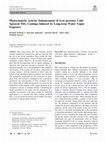
Journal of Thermal Spray Technology, 2021
This work shows that the titanium dioxide coatings obtained by low-pressure cold gas spraying wit... more This work shows that the titanium dioxide coatings obtained by low-pressure cold gas spraying with the use of the sol–gel amorphous TiO2 powder are characterized by photocatalytic activity despite their partial amorphous content. Moreover, the research outcome suggests that the decomposition rate of organic pollutants is enhanced after long-term exposure to moisture. The condensation humidity test is not detrimental to the continuity and integrity of the coating, but the phase composition of coatings changes—with the exposure to water vapor, the portion of the amorphous phase crystallizes into brookite. The mechanism responsible for the conversion of amorphous TiO2 into brookite is attributed to the water-driven dissolution and reprecipitation of TiO6 octahedra. It has been shown that an additional parameter necessary for the stabilization of the brookite is the oxygen depletion of the amorphous structure of titanium dioxide. Considering the results presented in this paper and the a...
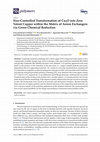
Polymers, 2020
Composite materials containing zero valent copper (ZVC) dispersed in the matrix of two commercial... more Composite materials containing zero valent copper (ZVC) dispersed in the matrix of two commercially available strongly basic anion exchangers with a macroreticular (Amberlite IRA 900Cl) and gel-like (Amberlite IRA 402OH) structure were obtained. Cu0 particles appeared in the resin phase as the product of the reduction of the precursor, i.e., copper oxide(I) particles previously deposited in the two supporting materials. As a result of a one-step transformation of preformed Cu2O particles as templates conducted using green reductant ascorbic acid and under mild conditions, macroporous and gel-type hybrid products containing ZVC were obtained with a total copper content of 7.7 and 5.3 wt%, respectively. X-ray diffraction and FTIR spectroscopy confirmed the successful transformation of the starting oxide particles into a metallic deposit. A scanning electron microscopy study showed that the morphology of the deposit is mainly influenced by the type of matrix exchanger. In turn, the dry...

Coatings, 2020
Intermetallic compounds, especially aluminides, show good high-temperature strength, oxidation re... more Intermetallic compounds, especially aluminides, show good high-temperature strength, oxidation resistance, high melting points, and thus have received considerable attention as potential substitutes for superalloys in high-temperature applications. Aluminides are especially interesting because they are stable up to the critical temperature of ordering, which is close to the melting temperature. In the Al-Ni system, the most studied intermetallics are Ni3Al, NiAl and NiAl3. In the presented study, Al and Ni powders were mixed together with Al2O3 in various proportions to produce dense coatings by low-temperature cold spraying. Two types of post-deposition treatments were applied to produce aluminides, namely furnace heating and resistance spot welding. The former caused a long time diffusion while the latter a self-propagating high temperature synthesis. Both heating methods enabled formations of intermetallic phases. However, the furnace heating provides high porosity. The microstru...
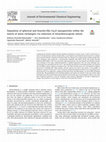
Journal of Environmental Chemical Engineering, 2020
Considering the biocidal, sorption and photocatalytic performance of parent Cu 2 O, in order to p... more Considering the biocidal, sorption and photocatalytic performance of parent Cu 2 O, in order to prevent the release of its nanostructures into the cleaned media, a Cu 2 O deposit was introduced into the matrix of a synthetic porous material whereby a hybrid ion exchanger (HIX) was obtained. Two commercially available strongly basic anion exchangers with respectively a macroreticular (Amberlite IRA 900Cl, M/An) and gel-like structure (Amberlite IRA 402OH, G/An) were used as the supporting materials. The Cu 2 O deposit was introduced into the anion exchanger in two steps, conducted batchwise at ambient temperature. First, the anion exchanger functional groups were transformed into the CuCl 4 2 form and then the polymeric intermediate product was contacted with an alkaline reducer solution to precipitate Cu 2 O. The effects of many factors were investigated to optimize the process of obtaining HIX. When ascorbic acid (not glucose) was used as the reducer, it was possible to introduce as much as 9.7 wt% and 7.3 wt% of Cu 2 O into respectively the M/An and the G/An. The products were characterized by X-ray diffraction, scanning electron microscopy with EDS analysis, as well as FTIR and Raman spectroscopy. The morphologies of the obtained products were found to be sensitive to the type of basic anion exchangers used. Microscopic analysis showed that the Cu 2 O in both types of used polymeric matrices was in the form of spherical particles of a size not exceeding 1.0 μm. However, depending on the type of supporting exchanger these particles occurred singly or in the form of bracelets-like clusters. gas sensing [9-14]. Metal oxide NPs have found many environmental applications, including water purification [15-17], which in the case of Cu 2 O NPs derives from their antimicrobial activity [18-20], sorption properties [21,22] and photocatalytic activity [23-30]. However, the fine Cu 2 O powder suspended in water is difficult to separate and collect from the reaction medium, which impedes and complicates the purification process. Simultaneously, the treated water can be recontaminated with cuprous oxide NPs causing the adverse biological effects in the environment [31,32]. A convenient solution to this problem is to combine Cu 2 O NPs with a carrier (such as carbon nanotubes, graphene oxide, chitosan, sepiolite, mineral wool fibres, cotton fabric, polysulfone membrane and active carbon), which makes them easily separable from water after purification [33-41]. Among metal oxide supporting materials ion exchangers-porous resins in the form of beads, which are insoluble but swellable in wateroffer many advantages including high mechanical strength, permeability and the excellent hydraulic characteristics, which enable their

Coatings, 2019
A major challenge in materials engineering is the development of new materials and methods and/or... more A major challenge in materials engineering is the development of new materials and methods and/or novel combination of existing ones, all fostering innovation. For that reason, this study aims at the synergy between low-pressure cold spray (LPCS) as a tool for coating deposition and sol-gel technique for fabrication of the feedstock powder. The complementarity of both methods is important for the examined topic. On one side, the LPCS being automized and quick mean provides the solid-state of feedstock material in nondestructive conditions and hence the hydrophobicity imparted on the sol-gel route is preserved. On the other side, the sol-gel synthesis enables the production of oxide materials with enhanced deformability due to amorphous form which supports the anchoring while LPCS spraying. In the paper, several aspects including optimal fluoroalkylsilane (FOTS) concentration or substrate roughness are examined initially for altering the superhydrophobicity of produced coatings. Furt...
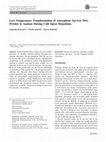
Journal of Thermal Spray Technology, 2018
Nanocrystalline TiO 2 coatings were successfully deposited on metallic substrate surfaces through... more Nanocrystalline TiO 2 coatings were successfully deposited on metallic substrate surfaces through lowpressure cold spray. Sol-gel amorphous TiO 2 dry gel was for the first time used as a feedstock powder. Agglomerated morphology of the amorphous powder with high-density packing of particles and reduced pores number was an important factor for successful low-pressure cold spraying. However, in the present study one more factor contributing to anchoring of TiO 2 particles by cold gas spraying onto a substrate was indicated. This factor enabling effective powder deposition and coating production is based on an exotic for conventional ceramic materials' plastic deformation of amorphous powder. Furthermore, the detailed analysis of SEM, Raman and XRD measurements clearly demonstrated that amorphous titanium dioxide is transformed into crystalline anatase form during the process of low-pressure cold spraying. Keywords ceramic low-pressure cold spray coatings Á low-pressure cold spray Á sol-gel Á titanium dioxide deposition & Agnieszka Baszczuk

Materials Science-Poland, 2016
Different types of titanate one-dimensional nanostructured materials were synthesized and charact... more Different types of titanate one-dimensional nanostructured materials were synthesized and characterized using scanning and transmission electron microscopy, X-ray diffraction and Raman spectroscopy. The results presented in this work unquestionably showed dependence of morphology and structure of the titanate nanopowders on parameters of hydrothermal synthesis. It was found that nanotubes, nanowires and nanoribbons are three unavoidable kinetic products of hydrothermal reaction. Moreover, increasing temperature of reaction or hydrothermal treatment duration results in acceleration of nanotube-nanowire-nanoribbon transformation. However, the sequence of titanate morphology transformation is invariable. The detailed studies further revealed that the crystal structure of hydrothermally prepared nanotubes and nanowires are indistinguishable but the determination of the exact structure is practically impossible. Because of higher crystallinity, the structure of nanoribbons can be establi...

Surface Engineering, 2017
Studies on bonding of aluminium alloys to steels are popular because these are structural materia... more Studies on bonding of aluminium alloys to steels are popular because these are structural materials widely used in a variety of industries. However, joining these dissimilar materials is difficult mainly because of the formation of brittle intermetallic compounds. This paper presents a study on welding aluminium to steel by resistance spot welding. Before the welding, steel surface was covered by cold spraying with the layer of aluminium, nickel and nickel-aluminium. This way, instead of the welding of dissimilar materials, the welding of aluminium to aluminium (or nickel) layer pre-deposited on the steel sample was performed. The feasibility of using interlayers for improving the welding of dissimilar materials was tested using SEM, EDX and XRD. Mechanical properties of welds were investigated by microhardness and shear strength tests. The results showed that the coating allowed to decrease hardness in the welding zone and to increase the shear strength of the weld.

NATO Science for Peace and Security Series C: Environmental Security, 2008
ABSTRACT Sol-gel technology has attracted considerable attention due to possibility of obtaining ... more ABSTRACT Sol-gel technology has attracted considerable attention due to possibility of obtaining submicron and nano-sized materials. The method of silica and titania nanopowders and thin films obtaining will be presented. Also properties and prospective application of these materials will be express. Additionally, methods of obtaining nanomaterials with different grains shape and specific properties (submicron spherical silica powders, titania nanofibers) will be showed. One of the main advantages of the sol-gel technique is the easiness of doping of the obtained materials with various substances (inorganic, organic, biological). Materials activated this way possess several useful properties. For example, silica spherical matrices with metallic nano-islands on their surface will be presented. Such silver-doped silica powders display anti-microbial capabilities and can be used to obtain doped thin-film coatings e.g. for the production of bacteriostatic textiles. Moreover, materials obtained by the sol-gel method have found wide application in the area of sensors. Examples of optical sensors based on sol-gel derived thin films and optical fiber or planar wave-guide will be also presented.

Advances in clinical and experimental medicine : official organ Wroclaw Medical University
Biodegradable carrier materials with nontoxic degradation products are very valuable for deliveri... more Biodegradable carrier materials with nontoxic degradation products are very valuable for delivering drugs and biologically active molecules. Many organic systems (such as liposomes, micelles and polymeric nanoparticles) and inorganic systems (metal oxides and silica) have been researched for delivering active substances to organs. Silica seems to be one of the most interesting and promising materials. The aim of this study was to investigate the SiO2 elimination process from rats' organisms and to ascertain the distribution and prospective accumulation sites of the silica particles. A suspension of silica particles (Ø 150 nm) in 0.9% NaCl solution was introduced into rats' circulatory system. The degradation of these particles over time and their accumulation in the heart, lungs, kidneys and liver were observed. It was found that 36% of the introduced silica particles were excreted with urine after four days. The remaining particles were accumulated in the kidneys and lungs,...
Journal of Sol-Gel Science and Technology, 2009
The aim of this study was to investigate antimicrobial activity of textiles doped with silver in ... more The aim of this study was to investigate antimicrobial activity of textiles doped with silver in different forms. Three types of textiles were prepared and examined: textiles doped with commercially available Ag nanoparticles, textiles doped with commercial colloidal silver and textiles doped with silver silica SiO2/Ag spheres. The specimens of silica submicron spheres were synthesized by the sol–gel method as

Journal of Alloys and Compounds, 2014
In this work, the size, distribution, morphology and optical absorption properties of silver nano... more In this work, the size, distribution, morphology and optical absorption properties of silver nanoparticles are regulated by controlling the type of spherical silica substrate. Two different types of SiO 2 microparticles with unmodified and amino-functionalized surface are used as a matrix for Ag nanocrystals deposition. In both cases, silver ions are located on the substrate surface and then are thermally reduced to metallic silver, however, modification of silica spheres with-NH 2 groups enables the accomplishment of Ag ions reduction at considerably lower temperatures. Controlled surface functionalization of silica substrate clearly affects the morphology and optical absorption properties of obtained silver nanoparticles. Amine functional groups have a significant influence on the silica dense coverage by Ag nanoparticles. Dense packing of nano-sized metallic silver particles causes red shifting and broadening of surface plasmon resonance (SPR) absorption peak compared to sparse nanoparticles distribution. The size of obtained Ag nanocrystals is ranged from 3 nm to 20 nm depending on the selected silica substrate as well as silver concentration.
International Journal of Antimicrobial Agents, 2007
Journal of Alloys and Compounds, 2006
Structure D 2000 Synthesis and Crystal Structure of Two Novel Layered Compounds Ba 3 InBiO 7-x an... more Structure D 2000 Synthesis and Crystal Structure of Two Novel Layered Compounds Ba 3 InBiO 7-x and Ba4InBiO8-x and Their Water Containing Derivatives.-The new title perovskite compounds are synthesized by solid state reactions of stoichiometric mixtures of BaCO3, Bi2O3, and In2O3 (700°C, 24 h). As revealed by powder XRD, Ba3InBiO7-x and Ba4InBiO8-x are the n = 2 and 1 members of the Ruddlesden-Popper series and crystallize in the tetragonal space group I4/mmm. The structures can be described as an intergrowth of perovskite-like Ba(In,Bi)O3-δ with rock-salt BaO layers. Upon exposure to air both compounds readily form hydrates by intercalation of water into the layered structures.
European Journal of Echocardiography, 2006
Conclusion: LVM, maximum wall thickness, severity and diffuse late enhancement pattern were assoc... more Conclusion: LVM, maximum wall thickness, severity and diffuse late enhancement pattern were associated with greater deterioration in diastolic function and increase in filling pressures.










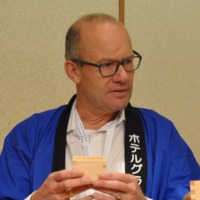
Uploads
Papers by Agnieszka Baszczuk